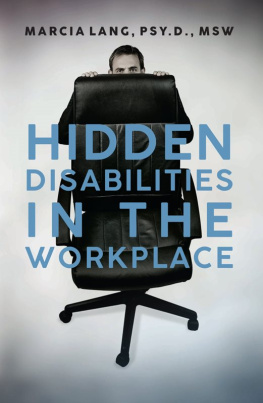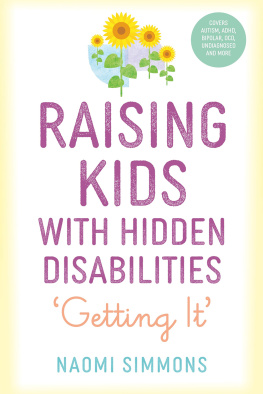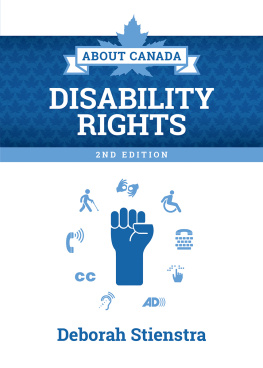Contents


Charleston, SC
www.PalmettoPublishing.com
Hidden Disabilities in the Workplace
Copyright 2021 by Marcia Lang, Psy.D., MSW
All rights reserved
No portion of this book may be reproduced,
stored in a retrieval system, or transmitted in any form
by any meanselectronic, mechanical, photocopy, recording,
or otherexcept for brief quotations in printed reviews,
without prior permission of the author.
Paperback ISBN: 9781-685153212
eBook ISBN: 9781-685153229
Table of Contents
T his guide is intended to be advisory only and is intended to help personnel working on the implementation of workplace accommodations due to disabilities. It is also not a legal guide for addressing workplace disabilities. It is neither all-encompassing nor a directive on how to accommodate specific disabilities in the workplacethere are no template solutions to disabilities in the workplace. Each person with a disability is unique and thus has unique accommodation requirements, with each needing to be addressed on a case-by-case basis. The examples presented herein are based on real situations, with identifying details altered to protect privacy. The information presented in this book is the professional opinion of the author, based on extensive work experience in this field.
W hat is a disability? According to the Americans with Disabilities Act (ADA), a disability is defined as a physical or mental impairment that substantially limits one or more major life activities. This includes people who have a record of an impairment, even if the impairment is not currently active. A disability is not an acute, short-term condition but instead is a chronic condition that significantly impacts daily life functions. Acute conditions are medical conditions that will likely get better over a short amount of time. However, some acute medical conditions can morph into a chronic condition and thus become a disability. For example, a concussion is likely to heal over a few months, but in some cases this traumatic brain injury may not heal as expected and physical and cognitive functioning may not improve. Now, the concussion has become a chronic condition and has transformed into a disability.
Disabilities are far more prevalent in society than most people realize. According to 2018 data from the Centers for Disease Control and Prevention (CDC), 26 percent of Americans, about one in four people, have some type of disability. Additionally, 13.7 percent have a disability related to mobility, such as climbing stairs or walking. About 10.8 percent have a cognitive disability that involves difficulty concentrating, remembering, or decision-making. About 6.8 percent cannot live independently or struggle with doing errands, 5.9 percent are deaf or have serious difficulty hearing, 4.6 percent have a vision disability such as blindness or low vision, and 3.6 percent of people have a disability that involves challenges with self-care, dressing, or bathing. And the older people get, the greater the chance of having a disability. Two in five adults over the age of sixty-five have a disability. The CDC also reports that people with a disability have frequent mental distress, reported as occurring 4.6 times as often when compared to those without a disability. And it is not just the United States with significant disability rates; according to the World Health Organization (WHO), about 15 percent of the world's population has some type of disability.
These statistics start to indicate the significant prevalence of disabilities in society. I think these numbers are actually on the low side for the actual number of people living with a disability. Hidden disabilities (i.e., those that are nonobvious) often go unreported. These people are not part of any government-funded rehabilitation programs, nor are they in a system that tracks such statistics. Typically, people with a hidden disability seek help from a primary care or internal medicine doctor, or maybe they see a specialist, but these numbers are not normally tracked by the CDC or WHO. Many people with hidden disabilities do not seek medical care at all and just live with it.
In addition, the above statistics dont address psychiatric conditions, such as anxiety or depression, as primary disabilities. Psychiatric disabilities are among the most common disabilities in society today. The National Institute of Mental Health estimates that 16.2 million US adults had at least one major depressive episode in 2016. This represents 6.7 percent of the US adult population. According to the Anxiety and Depression Association of America (ADAA), anxiety disorders are the most common mental illness in the United States, affecting 40 million people, about 18.1 percent of the population. However, only 36.9 percent of those with anxiety seek treatment.
Apparently, the reported statistics on the prevalence of disabilities are underreported. It is quite likely that those in the workplace will encounter employees with one or more disabilities who are not accounted for in the statistics gathered by the CDC or WHO. This means the presence of disabilities is often unexpected and unacknowledged. However, these disabilities should be expected, even if not visible.
Some severe disabilities are more obvious. This may include blindness, missing limbs, significant mobility impairments, paralysis, dwarfism, or disfigurement. Deafness is not normally immediately obvious. Developmental disabilities may or may not be obvious. Epilepsy and seizure disorders, along with intellectual disabilities, are not obvious either. And significant psychiatric disorders, such as bipolar disorder or schizophrenia, are also not visibly obvious.
Other disabilities are not considered as severe. These include nonparalytic orthopedic impairments such as chronic pain and weakness, nervous system disorders such as migraines and multiple sclerosis (MS), cardiovascular heart disease and blood diseases such as sickle cell anemia or hemophilia, depression, anxiety, or other psychiatric disorders, diabetes, orthopedic impairments such as osteoarthritis, kidney dysfunction, cancer, learning disabilities, attention deficit hyperactivity disorder (ADHD), gastrointestinal disorders, autoimmune disorders, a history of substance abuse, and endocrine disorders such as thyroid disorders. None one of these disabilities are obvious; they can all be considered hidden, as are the majority of disabilities. Do not expect to identify a disability in the workplace just by looking at a person.
Navigating life's challenges can be hard, often challenging, due to a disability, especially with the extra effort required. Imagine living life where, each day, there is pain. Maybe understanding the world around you takes extra focus and concentration. And perhaps just getting out of bed is a strugglephysically, emotionally, or both. The majority of disabilities are not obvious. Some may say they are hidden, but the term hidden is not fully accurate. The nonobvious disabilities are there in plain sightone just needs to pay attention and be aware of what is happening around them to see the struggles that many people face each day. Are employees wincing, tearful, exhausted, or taking a lot of medications throughout the day? Look around and observe what is really going on.
Employers are often challenged to accommodate nonobvious disabilities. It is easier to lower the height of a printer or install a ramp for a wheelchair user. A deaf person can have a sign language interpreter, and a blind employee may use braille or an assistive technology screen reader. But what do you do when an employee has depression, anxiety, a learning disability, or chronic pain? There is no ramp that can be installed to accommodate a nonobvious disability.









